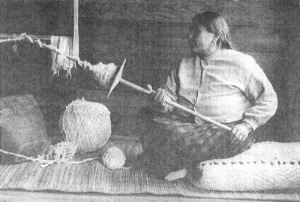Indigenous peoples of the Pacific Northwest Coast
== Indigenous Peoples of the Pacific Northwest Coast ==
The Indigenous peoples of the Pacific Northwest Coast are the indigenous peoples who inhabit the coastal regions of the Pacific Northwest in North America. This area includes parts of the modern-day United States and Canada, specifically the coastal regions of Washington, Oregon, British Columbia, and Southeast Alaska.
Geography[edit | edit source]
The Pacific Northwest Coast is characterized by its rugged coastline, temperate rainforests, and numerous rivers and inlets. This region's rich natural resources have supported the Indigenous peoples for thousands of years, providing abundant fish, game, and plant life.
Cultural Groups[edit | edit source]
The Indigenous peoples of this region are diverse, with numerous distinct cultural groups, each with its own language, traditions, and social structures. Some of the prominent groups include:
Languages[edit | edit source]
The languages spoken by the Indigenous peoples of the Pacific Northwest Coast belong to several different language families, including the Wakashan languages, Salishan languages, and Tsimshianic languages. These languages are an integral part of the cultural identity and heritage of these communities.
Social Structure[edit | edit source]
The social structure of these Indigenous groups is often complex, with a strong emphasis on kinship and clan systems. Many groups are organized into matrilineal clans, where lineage and inheritance are traced through the mother's line. Social status and leadership roles are often hereditary, passed down through generations.
Economy[edit | edit source]
The economy of the Indigenous peoples of the Pacific Northwest Coast has traditionally been based on fishing, hunting, and gathering. The region's abundant marine resources, particularly salmon, have been central to their way of life. They also engaged in trade with neighboring groups, exchanging goods such as cedar bark, shellfish, and crafted items.
Art and Culture[edit | edit source]
The art and culture of the Pacific Northwest Coast Indigenous peoples are renowned for their intricate and symbolic designs. They are known for their totem poles, masks, and carvings, which often depict animals and mythological beings. These art forms are not only aesthetic but also serve as important cultural and historical records.
Potlatch[edit | edit source]
The potlatch is a significant cultural ceremony among many Pacific Northwest Coast Indigenous groups. It involves feasting, dancing, and the giving of gifts, and serves to reinforce social bonds, distribute wealth, and mark important events such as births, deaths, and marriages.
Modern Issues[edit | edit source]
Today, the Indigenous peoples of the Pacific Northwest Coast face various challenges, including issues related to land rights, cultural preservation, and economic development. Many communities are actively working to revitalize their languages and traditions while advocating for their rights and sovereignty.
Related Pages[edit | edit source]
![]() This Indigenous peoples-related article is a stub. You can help WikiMD by expanding it.
This Indigenous peoples-related article is a stub. You can help WikiMD by expanding it.
Search WikiMD
Ad.Tired of being Overweight? Try W8MD's physician weight loss program.
Semaglutide (Ozempic / Wegovy and Tirzepatide (Mounjaro / Zepbound) available.
Advertise on WikiMD
|
WikiMD's Wellness Encyclopedia |
| Let Food Be Thy Medicine Medicine Thy Food - Hippocrates |
Translate this page: - East Asian
中文,
日本,
한국어,
South Asian
हिन्दी,
தமிழ்,
తెలుగు,
Urdu,
ಕನ್ನಡ,
Southeast Asian
Indonesian,
Vietnamese,
Thai,
မြန်မာဘာသာ,
বাংলা
European
español,
Deutsch,
français,
Greek,
português do Brasil,
polski,
română,
русский,
Nederlands,
norsk,
svenska,
suomi,
Italian
Middle Eastern & African
عربى,
Turkish,
Persian,
Hebrew,
Afrikaans,
isiZulu,
Kiswahili,
Other
Bulgarian,
Hungarian,
Czech,
Swedish,
മലയാളം,
मराठी,
ਪੰਜਾਬੀ,
ગુજરાતી,
Portuguese,
Ukrainian
Medical Disclaimer: WikiMD is not a substitute for professional medical advice. The information on WikiMD is provided as an information resource only, may be incorrect, outdated or misleading, and is not to be used or relied on for any diagnostic or treatment purposes. Please consult your health care provider before making any healthcare decisions or for guidance about a specific medical condition. WikiMD expressly disclaims responsibility, and shall have no liability, for any damages, loss, injury, or liability whatsoever suffered as a result of your reliance on the information contained in this site. By visiting this site you agree to the foregoing terms and conditions, which may from time to time be changed or supplemented by WikiMD. If you do not agree to the foregoing terms and conditions, you should not enter or use this site. See full disclaimer.
Credits:Most images are courtesy of Wikimedia commons, and templates, categories Wikipedia, licensed under CC BY SA or similar.
Contributors: Prab R. Tumpati, MD







